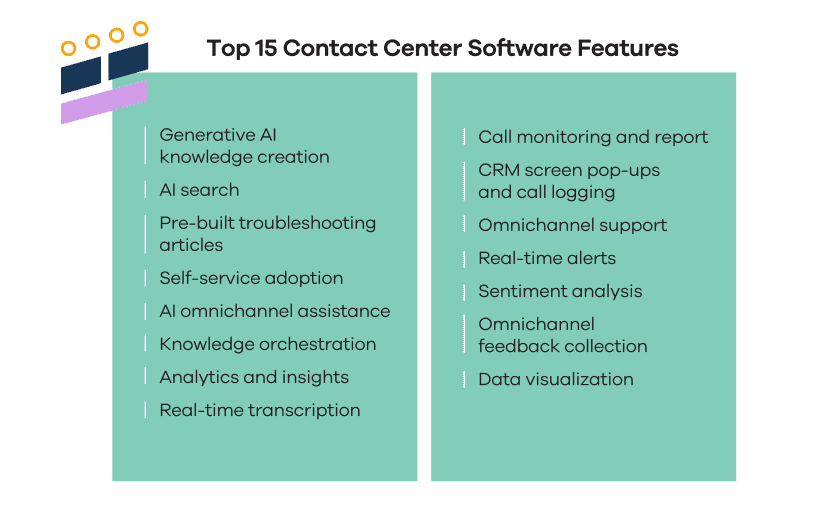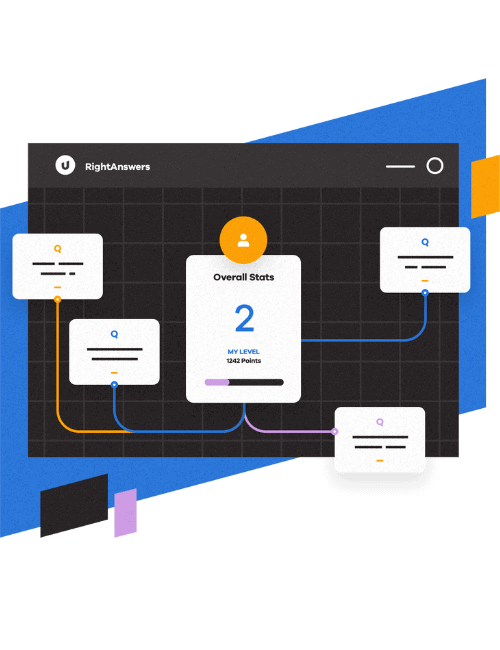Top 15 Contact Center Software Features of 2025
In the last few decades, contact center software has become a cornerstone of customer service, streamlining interactions and improving overall satisfaction. From simple call routing to advanced AI-powered chatbots, contact center solutions have become indispensable for businesses of all sizes.

When it comes to contact center software, there’s no one-size-fits-all solution. Oftentimes, it takes an ecosystem of solutions to power an efficient and product operation. Popular contact center software include:
- Knowledge management system: Knowledge management systems help organizations collect, organize, and share information. These contact center solutions can be used to store policies, procedures, training materials, and other important documents. By making this information easily accessible to employees, knowledge management solutions can improve efficiency, collaboration, and decision-making.
- Computer-telephony integration (CTI) software: CTI bridges the gap between computer systems and telephone systems. It allows incoming calls to be routed directly to an agent’s computer and integrates with other communication channels like email and chat. This improves efficiency, reduces manual tasks, and enhances the overall customer experience.
- Customer engagement software: Customer engagement software is a contact center solution that helps organizations gain valuable insights into their customers. By collecting and analyzing customer feedback, this software allows companies to improve their customer service interactions. This can lead to increased customer satisfaction, loyalty, and overall business success.
While all contact center software aim to improve efficiency and customer satisfaction, they can vary significantly in terms of features and capabilities. To identify the best solution for your specific needs, it’s essential to evaluate the key features offered by different providers. By understanding the unique strengths and weaknesses of each solution, you can make an informed decision and select the contact center software that will best support your business goals. Below, we’ve outlined the top 15 contact center software features.

Here are our top 15 contact center software features:
- Generative AI knowledge creation
- AI search
- Pre-built troubleshooting articles
- Self-service adoption
- AI omnichannel assistance
- Knowledge orchestration
- Analytics and insights
- Real-time transcription
- Call monitoring and report
- CRM screen pop-ups and call logging
- Omnichannel support
- Real-time alerts
- Sentiment analysis
- Omnichannel feedback collection
- Data visualization
1. Generative AI Knowledge Creation
Your knowledge management solution doesn’t operate without knowledge articles. But creating knowledge articles can be time-consuming and take up a lot of time. That’s why top knowledge management solutions leverage generative AI technology to easily create helpful knowledge articles your contact center agents can leverage. This frees up your team to focus on more strategic initiatives while ensuring your knowledge base remains comprehensive and up to date.
2. AI Search
Creating knowledge articles and support content is just one aspect of a successful knowledge management strategy. Your contact center agents also need to be able to find exactly what they’re looking for with just a few clicks. Fortunately, many of the best knowledge management solutions feature powerful AI search that allows users to find the information they need quickly and easily, regardless of how they phrase their query.
3. Pre-built Troubleshooting Articles
There’s no reason to reinvent the wheel if your questions have already been answered. Top contact center software, especially knowledge management solutions, come pre-loaded with a library of industry-specific troubleshooting articles covering common customer issues. This jumpstarts your knowledge base and empowers agents to resolve inquiries efficiently, even on their first day.
4. Self-service Adoption
Today’s consumers want and need to be able to find information on their own, and to do that, you need a self-service portal. Luckily, contact center software can help you provide intuitive and easy-to-use self-service options that empower customers to find answers and resolve issues independently. Plus, self-service can significantly reduce call volume and improve efficiency to minimize stress on your agents.
5. AI Omnichannel Assistance
Your customers don’t interact with you using a single channel, which is why it’s important your contact center provides a true omnichannel experience. Leading contact center solutions integrate seamlessly with chatbots, self-service portals, and agent desktops, allowing customers to access relevant knowledge articles regardless of which channel they choose.
6. Knowledge Orchestration
While contact center solutions make it easy to store and search for articles, they should also help you intelligently deliver knowledge to users. Many of the top knowledge management solutions offer robust knowledge orchestration capabilities, allowing you to personalize content delivery and ensure users receive the most relevant and helpful information at the right moment.
7. Analytics and Insights
A productive contact center requires high-quality insights and analytics to drive improvement. The industry’s best contact center software helps you identify gaps in your strategy, track user behavior, and measure the overall effectiveness of your efforts. This data allows you to continuously optimize your knowledge base and ensure it meets the evolving needs of your customers and agents.
8. Real-time Transcription
Your contact center agents deal with hundreds of calls per day, making it difficult and tiresome to keep track of every word that’s said. Luckily, the leading contact center solutions on the market offer real-time transcription capabilities that automatically convert spoken words into text during calls. This allows agents, supervisors, and quality analysts to accurately review conversations and identify room for improvement.
9. Call Monitoring and Report
To maximize contact center performance, you need insight into agent performance and customer interactions. When evaluating contact center software, you should look for ones equipped with advanced call monitoring and reporting features that offer insights into call duration, hold times, first-call resolution rates, and customer satisfaction scores. You can then use this data to identify opportunities for training and process optimization.
10. CRM Screen Pop-Ups and Call Logging
With personalization being a top priority for many consumers, it’s imperative your contact center agents have easy access to customer data and prior interactions. The best contact center solutions on the market have CRM screen pop-ups and call logging allowing agents to access relevant customer data and history instantly, providing personalized and efficient service.
11. Omnichannel Support
Today’s consumers expect a seamless experience across all channels. That’s why top contact center solutions offer omnichannel support, allowing agents to handle calls, chats, emails, and social media messages from a single platform. This empowers contact center agents to deliver consistent and personalized service, regardless of the channel used.
12. Real-time Alerts
Customer feedback can lose its value if you wait too long to collect it or respond. Fortunately, top-tier contact center software provides real-time alerts that empower you to quickly identify and address potential issues before they escalate.
13. Sentiment Analysis
Gauging customers’ opinions and satisfaction levels can be difficult to do manually. That’s why the best contact center solutions leverage advanced algorithms to accurately determine the emotional tone of customer feedback. Sentiment analysis can help you identify areas of satisfaction and dissatisfaction, as well as track changes in sentiment over time.
14. Omnichannel Feedback Collection
Customer feedback comes in many forms and channels, including email, web apps, and via phone. It’s critical your contact center software provides a comprehensive view of the customer experience and helps you identify areas for improvement across all touchpoints.
15. Data Visualization
To better identify areas of improvement, you need to make sense of your data. Data visualization can help you identify patterns, trends, and areas of focus. The best contact center solutions will make it easy to explore customer journeys, satisfaction levels, and other key metrics to gain actionable insights.

What Are The Benefits of These Contact Center Solutions?
Contact centers today cannot operate in a vacuum. To be successful, they need the right solutions to streamline their large workloads, provide quality customer service, and access the right knowledge when it’s needed most. Now that we’ve shared our top three contact center solutions and the challenges they help with, it’s time to peek into their benefits.
Benefits of Knowledge Management
The name alone makes knowledge management seem straightforward—it’s a way to assess, categorize, and access your organization’s information. But it does so much more, especially when it comes to contact centers.
Knowledge management software is arguably one of the most useful tools in your contact center agent’s arsenal. By having access to the most relevant knowledge about your organization and its customers, contact center agents are able to fast-track their onboarding and learning paths with anywhere on-the-job support. This convenient access to quality organizational knowledge also helps lighten agents’ cognitive workload. Instead of having to remember all the different policies, guidelines, and customer specific information, agents have direct access to all of that and more via AI-enabled search.
Knowledge management solutions also enable higher customer satisfaction because agents are able to utilize federated searches to increase first call resolution numbers. This means agents have so much useful information that they’re able to solve an issue in that first interaction without having multiple touchpoints with the customer. Ultimately, knowledge management solutions help to increase workplace efficiency for the contact center itself.
Benefits of CTI
As we mentioned above, computers have only been widely used for business since the 1980s. Finding a way to increase workplace efficiencies by connecting computers with telephone systems also began in the same decade but through a hardware solution. However, today many contact centers now rely on a cloud-based computer telephony integration (CTI) solution.
With this connection, contact center agents have customer calls with better context because information is pulled through the CRM and pops on the screen before speaking with a customer. The CTI connection gives agents a quick way to accurately click-to-dial directly from any CRM record and configure speed of dialing. Instead of spending time manually writing down each interaction, agents can now have an automated recording of inbound and outbound calls logged directly into their CRM. CTI also enables a one-click transfer for quickly rerouting calls to the right expert.
Basically, CTI solutions allow contact centers to scale at a quicker rate because of the efficiencies and productivities they help push forward. Without having to overhaul computer infrastructures, organizations are able to add instant value to their existing tech stack and bottom line.
Benefits of Customer Engagement Software
Customers are bombarded with so much information every day. Organizations looking to get through all the noise may feel like it’s an impossible uphill battle (and at times, it is). So, it’s not enough to merely have information about customers interacting with your organization. To take it to the next level, it’s important to have a better relationship with them and that’s where customer engagement software comes into play.
People want to have meaningful interactions with the companies they encounter, especially if they’ve spent money for a product or service. Customer engagement software allows just that. Upon collecting information throughout the customer journey, whether it’s through email, SMS, app, chat, web, or another avenue, agents can pull insights from those interactions for a more productive customer conversation. Over time, this helps to build that effective relationship.
Simply put, customer engagement software puts agents in the driver seat to be able to put the customer first and intelligently listen to their needs. With the information they gather across each and every communication channel, agents are better able to view trends and make correlations for more informed decisions. They’re able to take a more tailored approach to customer service for your organization by viewing data analysis, visualizations, and taxonomies for any customer. It also gives agents a way to have real-time customer resolutions.
How to Select the Best Contact Center Solution
When it comes to choosing a solution for your contact center, there are several moving pieces to factor in. From the information flowing in and out of it every day with agent to customer interactions and the inner workings of everyday operations at the organization itself, there are a variety of contact center solutions to think about. However, for the top three we’ve outlined—knowledge management, CTI, and customer engagement software— here are the steps we recommend following:
- Conduct an audit of existing solutions
- Categorize existing solutions into what works and what doesn’t work well
- Build out your organization’s contact center goals
- Determine any operational holes that new solutions could benefit
- Research all options based on your organization’s intended goals
- Compare each vendor’s different software features
- Pressure test those options in an employee focus group
Ideally your contact center solutions should uplift and enhance both agent and customer experiences. Your contact center solutions are arguably the core of your organization’s everyday operations. Because of that, whichever solution is chosen has to be carefully evaluated and selected with great importance. By going through each of the above outlined steps, your organization can ensure it’s choosing what’s best for its everyday contact center operations.
